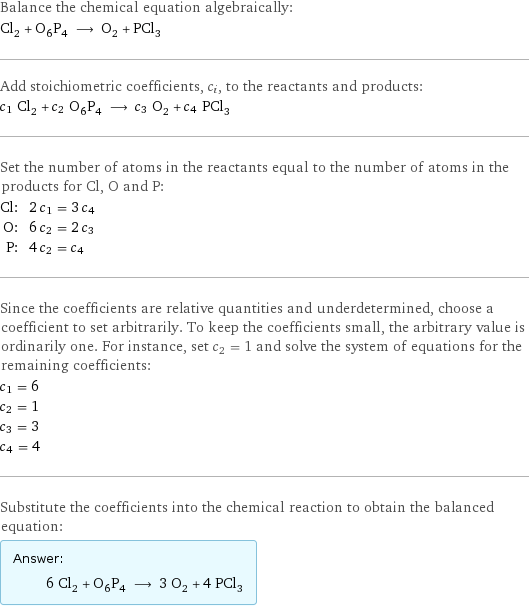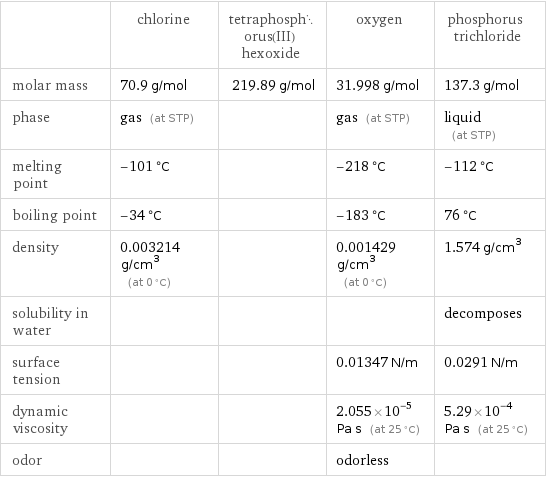Input interpretation

Cl_2 chlorine + O_6P_4 tetraphosphorus(III) hexoxide ⟶ O_2 oxygen + PCl_3 phosphorus trichloride
Balanced equation

Balance the chemical equation algebraically: Cl_2 + O_6P_4 ⟶ O_2 + PCl_3 Add stoichiometric coefficients, c_i, to the reactants and products: c_1 Cl_2 + c_2 O_6P_4 ⟶ c_3 O_2 + c_4 PCl_3 Set the number of atoms in the reactants equal to the number of atoms in the products for Cl, O and P: Cl: | 2 c_1 = 3 c_4 O: | 6 c_2 = 2 c_3 P: | 4 c_2 = c_4 Since the coefficients are relative quantities and underdetermined, choose a coefficient to set arbitrarily. To keep the coefficients small, the arbitrary value is ordinarily one. For instance, set c_2 = 1 and solve the system of equations for the remaining coefficients: c_1 = 6 c_2 = 1 c_3 = 3 c_4 = 4 Substitute the coefficients into the chemical reaction to obtain the balanced equation: Answer: | | 6 Cl_2 + O_6P_4 ⟶ 3 O_2 + 4 PCl_3
Structures

+ ⟶ +
Names

chlorine + tetraphosphorus(III) hexoxide ⟶ oxygen + phosphorus trichloride
Equilibrium constant
![Construct the equilibrium constant, K, expression for: Cl_2 + O_6P_4 ⟶ O_2 + PCl_3 Plan: • Balance the chemical equation. • Determine the stoichiometric numbers. • Assemble the activity expression for each chemical species. • Use the activity expressions to build the equilibrium constant expression. Write the balanced chemical equation: 6 Cl_2 + O_6P_4 ⟶ 3 O_2 + 4 PCl_3 Assign stoichiometric numbers, ν_i, using the stoichiometric coefficients, c_i, from the balanced chemical equation in the following manner: ν_i = -c_i for reactants and ν_i = c_i for products: chemical species | c_i | ν_i Cl_2 | 6 | -6 O_6P_4 | 1 | -1 O_2 | 3 | 3 PCl_3 | 4 | 4 Assemble the activity expressions accounting for the state of matter and ν_i: chemical species | c_i | ν_i | activity expression Cl_2 | 6 | -6 | ([Cl2])^(-6) O_6P_4 | 1 | -1 | ([O6P4])^(-1) O_2 | 3 | 3 | ([O2])^3 PCl_3 | 4 | 4 | ([PCl3])^4 The equilibrium constant symbol in the concentration basis is: K_c Mulitply the activity expressions to arrive at the K_c expression: Answer: | | K_c = ([Cl2])^(-6) ([O6P4])^(-1) ([O2])^3 ([PCl3])^4 = (([O2])^3 ([PCl3])^4)/(([Cl2])^6 [O6P4])](../image_source/f62dd4cdc1d6d5c2089c8d129d8e954e.png)
Construct the equilibrium constant, K, expression for: Cl_2 + O_6P_4 ⟶ O_2 + PCl_3 Plan: • Balance the chemical equation. • Determine the stoichiometric numbers. • Assemble the activity expression for each chemical species. • Use the activity expressions to build the equilibrium constant expression. Write the balanced chemical equation: 6 Cl_2 + O_6P_4 ⟶ 3 O_2 + 4 PCl_3 Assign stoichiometric numbers, ν_i, using the stoichiometric coefficients, c_i, from the balanced chemical equation in the following manner: ν_i = -c_i for reactants and ν_i = c_i for products: chemical species | c_i | ν_i Cl_2 | 6 | -6 O_6P_4 | 1 | -1 O_2 | 3 | 3 PCl_3 | 4 | 4 Assemble the activity expressions accounting for the state of matter and ν_i: chemical species | c_i | ν_i | activity expression Cl_2 | 6 | -6 | ([Cl2])^(-6) O_6P_4 | 1 | -1 | ([O6P4])^(-1) O_2 | 3 | 3 | ([O2])^3 PCl_3 | 4 | 4 | ([PCl3])^4 The equilibrium constant symbol in the concentration basis is: K_c Mulitply the activity expressions to arrive at the K_c expression: Answer: | | K_c = ([Cl2])^(-6) ([O6P4])^(-1) ([O2])^3 ([PCl3])^4 = (([O2])^3 ([PCl3])^4)/(([Cl2])^6 [O6P4])
Rate of reaction
![Construct the rate of reaction expression for: Cl_2 + O_6P_4 ⟶ O_2 + PCl_3 Plan: • Balance the chemical equation. • Determine the stoichiometric numbers. • Assemble the rate term for each chemical species. • Write the rate of reaction expression. Write the balanced chemical equation: 6 Cl_2 + O_6P_4 ⟶ 3 O_2 + 4 PCl_3 Assign stoichiometric numbers, ν_i, using the stoichiometric coefficients, c_i, from the balanced chemical equation in the following manner: ν_i = -c_i for reactants and ν_i = c_i for products: chemical species | c_i | ν_i Cl_2 | 6 | -6 O_6P_4 | 1 | -1 O_2 | 3 | 3 PCl_3 | 4 | 4 The rate term for each chemical species, B_i, is 1/ν_i(Δ[B_i])/(Δt) where [B_i] is the amount concentration and t is time: chemical species | c_i | ν_i | rate term Cl_2 | 6 | -6 | -1/6 (Δ[Cl2])/(Δt) O_6P_4 | 1 | -1 | -(Δ[O6P4])/(Δt) O_2 | 3 | 3 | 1/3 (Δ[O2])/(Δt) PCl_3 | 4 | 4 | 1/4 (Δ[PCl3])/(Δt) (for infinitesimal rate of change, replace Δ with d) Set the rate terms equal to each other to arrive at the rate expression: Answer: | | rate = -1/6 (Δ[Cl2])/(Δt) = -(Δ[O6P4])/(Δt) = 1/3 (Δ[O2])/(Δt) = 1/4 (Δ[PCl3])/(Δt) (assuming constant volume and no accumulation of intermediates or side products)](../image_source/e3f25652d0d192c74d1c7a2b7db44b68.png)
Construct the rate of reaction expression for: Cl_2 + O_6P_4 ⟶ O_2 + PCl_3 Plan: • Balance the chemical equation. • Determine the stoichiometric numbers. • Assemble the rate term for each chemical species. • Write the rate of reaction expression. Write the balanced chemical equation: 6 Cl_2 + O_6P_4 ⟶ 3 O_2 + 4 PCl_3 Assign stoichiometric numbers, ν_i, using the stoichiometric coefficients, c_i, from the balanced chemical equation in the following manner: ν_i = -c_i for reactants and ν_i = c_i for products: chemical species | c_i | ν_i Cl_2 | 6 | -6 O_6P_4 | 1 | -1 O_2 | 3 | 3 PCl_3 | 4 | 4 The rate term for each chemical species, B_i, is 1/ν_i(Δ[B_i])/(Δt) where [B_i] is the amount concentration and t is time: chemical species | c_i | ν_i | rate term Cl_2 | 6 | -6 | -1/6 (Δ[Cl2])/(Δt) O_6P_4 | 1 | -1 | -(Δ[O6P4])/(Δt) O_2 | 3 | 3 | 1/3 (Δ[O2])/(Δt) PCl_3 | 4 | 4 | 1/4 (Δ[PCl3])/(Δt) (for infinitesimal rate of change, replace Δ with d) Set the rate terms equal to each other to arrive at the rate expression: Answer: | | rate = -1/6 (Δ[Cl2])/(Δt) = -(Δ[O6P4])/(Δt) = 1/3 (Δ[O2])/(Δt) = 1/4 (Δ[PCl3])/(Δt) (assuming constant volume and no accumulation of intermediates or side products)
Chemical names and formulas

| chlorine | tetraphosphorus(III) hexoxide | oxygen | phosphorus trichloride formula | Cl_2 | O_6P_4 | O_2 | PCl_3 Hill formula | Cl_2 | O_6P_4 | O_2 | Cl_3P name | chlorine | tetraphosphorus(III) hexoxide | oxygen | phosphorus trichloride IUPAC name | molecular chlorine | | molecular oxygen | trichlorophosphane
Substance properties

| chlorine | tetraphosphorus(III) hexoxide | oxygen | phosphorus trichloride molar mass | 70.9 g/mol | 219.89 g/mol | 31.998 g/mol | 137.3 g/mol phase | gas (at STP) | | gas (at STP) | liquid (at STP) melting point | -101 °C | | -218 °C | -112 °C boiling point | -34 °C | | -183 °C | 76 °C density | 0.003214 g/cm^3 (at 0 °C) | | 0.001429 g/cm^3 (at 0 °C) | 1.574 g/cm^3 solubility in water | | | | decomposes surface tension | | | 0.01347 N/m | 0.0291 N/m dynamic viscosity | | | 2.055×10^-5 Pa s (at 25 °C) | 5.29×10^-4 Pa s (at 25 °C) odor | | | odorless |
Units
